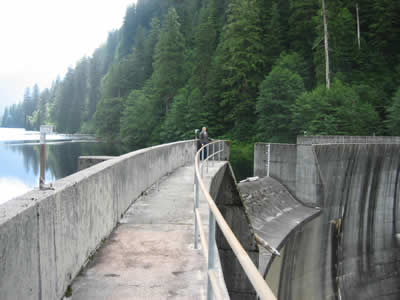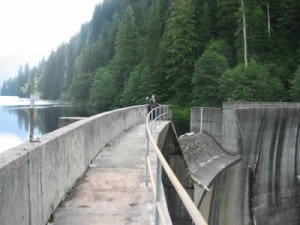A regional electrical provider is soliciting proposals for new energy projects. The Southeast Alaska Power Agency has put out a “request for offers of power” in an effort to eventually tie more electricity into the grid that currently serves Petersburg, Wrangell and Ketchikan. SEAPA explained the effort during a regional energy meeting in Petersburg this month (2/06). Matt Lichtenstein filed this report for part two of our coverage of that gathering.
For mobile-friendly audio, click here.
As demand for electricity grows in in the region, the Southeast Power Agency is working on several initiatives aimed at increasing the supply of hydro-power and other alternatives to diesel generation. One of SEAPA’s most recent efforts is called a “Request for Offers of Power and Energy”. It’s basically a call-out to any public or private energy developers who are interested building new projects and selling electricity to SEAPA.
“It does a few things I think are very important,” said SEAPA CEO Trey Acteson. During a regional energy meeting in Petersburg this month, Acteson explained the request for offers to a group of about thirty Southeast municipal leaders and other officials.
“First of all, it kind of helps address the concern that the current power sales agreement in our area is a detriment to new hydro-development. Basically, it provides a mechanism for all people to all people to propose to selling into our system.”
SEAPA operates under a long-term power sales agreement with the three municipalities that created the agency. Under that agreement, the power from SEAPA’s two hydro plants and other infrastructure is dedicated to the public utilities in Petersburg, Wrangell and Ketchikan at a firm wholesale rate. That’s resulted in some of the cheapest hydro-electric power in the state.
According to Acteson, the request for offers is not limited to hydro-power:
“I think we may even see, it may propose some new options we really haven’t fully considered yet such as biomass. I’ve already had people approach me for biomass that have basically an unlimited source of fuel and have a potential location right under the intertie. So, there are things out there that are outside of just hydro as well. The RFO opens the door to that.”
Acteson explained that the RFO has options for smaller-scale offers of energy as well proposals for developing a major project in partnership with SEAPA:
“Maybe they’ve got a project and they’ve got a preliminary license or they bring some type of value to developing some type of a resource and they can bring that forward ans we’ll look at that. Maybe that makes sense. So, options 1,2, and 3 are kind of short, mid-term options and option four could be a long-term, bigger project.” :21
Acteson emphasized that hydro-development takes many years. So, he said people need to consider how best to use their current resources including diesel generation:
“Diesel’s going to be our transition fuel to get to the next increment of hydro and as mentioned, it’s OK to burn a little diesel. I know everybody doesn’t want to burn any diesel but the fact is, we are going to burn diesel and how can we best manage that with the resources that we have and the resources that we’re trying to implement.”
As for choosing a new hydro site, Acteson urged caution, saying there were good reasons why some proposed projects have not been developed.
“So, when somebody says ‘Oh wow! This license came up. We should go get it!” Well, I just think that should be a very measured approach and people need to think really hard (about) why wasn’t that project successful the first several years that somebody was trying to develop it. And perhaps is there a different approach. Is there something we can do different? Was it designed wrong? Was it a funding issue? Was it the wrong size? Was it the revenue base? There are just so many things that you have to consider.”
The legislature has provided three-million dollars to help SEAPA pursue several initiatives. More than half will help fund the gathering of stream and weather data to evaluate potential hydro-development sites in central and southern southeast. That will include field work as well as the use of existing data.
Eric Wolfe is SEAPA’s Director of Special Projects:
“We’re going to look at every site in the next five years that we can get a permit for that we’ve already vetted on an economic basis that takes the extended system from Metlakatla to Kake. Now, some of them don’t need much work. Some of them need a lot”
Wolfe listed some of the sites SEAPA plans to look at such as Ruth Lake and Cascade Creek at Thomas Bay near Petersburg and Virginia lake near Wrangell, among others.
The Alaska Energy Authority has endorsed SEAPA’s efforts to seek out new sources of power and Deputy Director Gene Therriault said he was glad to see them go forward.
However, he cautioned that new projects will likely need to pay for themselves over time because the state’s ability to give away grant funds, as opposed to loans, is diminishing.
“The days of just 100 percent state grants and, you know, just keep going back to the trough. They may be coming to a close and it’s not just because the shift in the legislature and your elected officials are not in the key positions. Money’s getting tighter. Throughput in the pipeline is going down. And so that’s all part of the future.”
SEAPA is governed by a board of directors with representatives from Petersburg, Ketchikan and Wrangell. The request for offers of power can be viewed online at SEAPA’s website.











